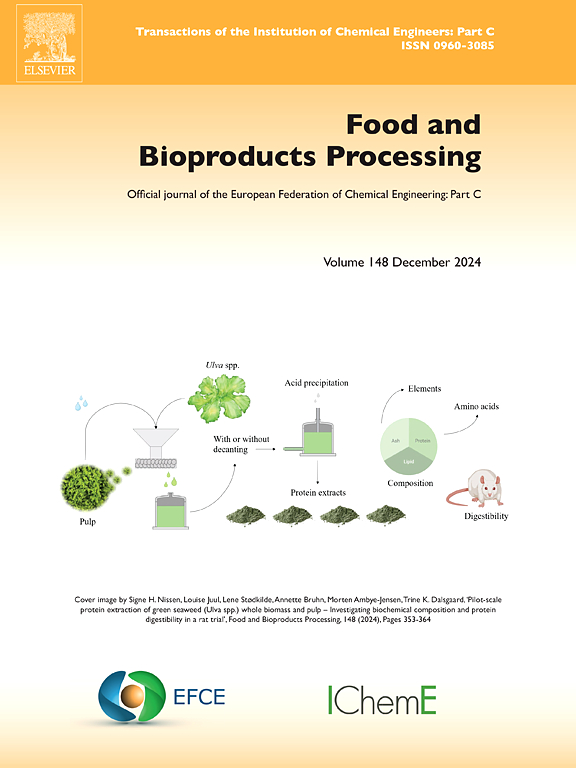在机械搅拌的喷射床中干燥废橙汁
IF 3.5
2区 农林科学
Q2 BIOTECHNOLOGY & APPLIED MICROBIOLOGY
引用次数: 0
摘要
橙汁废弃物是一种大规模生产的农工生物废弃物,可以通过干燥转化为原料来源。橙汁固体渣的干燥是在一个机械搅拌喷淋床上进行的,在搅拌轴周围装有四组等间距的叶片。实验温度为40 ~ 80℃,空气流速为最小喷射速度的1 ~ 5 倍。机械搅拌已被证明可以增加固体的运动,特别是在靠近内壁的区域。伪流化制度允许改善床的均匀性和过程的稳定性。干燥能量需求为常规床的12.6 - 23.4% %。在固体橙汁残留物的大部分干燥时间内,由于在该过程中使用的低空气流速,空气在出口处饱和。本文章由计算机程序翻译,如有差异,请以英文原文为准。
Drying of orange juice waste in a mechanically stirred spouted bed
Orange juice waste is an agro-industrial bio-waste produced on large-scale, which may be transformed into a source of raw material through drying. Drying of orange juice solid residue was carried out in a mechanically stirred spouted bed equipped with four sets of equally spaced blades placed around the stirrer shaft. The experiments were conducted at temperatures between 40 and 80°C with air flow rates of 1–5 times the minimum spouting velocity. Mechanical agitation has proven to increase the movement of solids, especially in areas close to the internal wall. The pseudo-fluidized regime allowed improving both bed uniformity and process stability. The drying energy demand was 12.6–23.4 % of that of the conventional bed. During much of the drying time of the solid orange juice residue, the air was saturated at the exit due to the low air flow rates used in the process.
求助全文
通过发布文献求助,成功后即可免费获取论文全文。
去求助
来源期刊

Food and Bioproducts Processing
工程技术-工程:化工
CiteScore
9.70
自引率
4.30%
发文量
115
审稿时长
24 days
期刊介绍:
Official Journal of the European Federation of Chemical Engineering:
Part C
FBP aims to be the principal international journal for publication of high quality, original papers in the branches of engineering and science dedicated to the safe processing of biological products. It is the only journal to exploit the synergy between biotechnology, bioprocessing and food engineering.
Papers showing how research results can be used in engineering design, and accounts of experimental or theoretical research work bringing new perspectives to established principles, highlighting unsolved problems or indicating directions for future research, are particularly welcome. Contributions that deal with new developments in equipment or processes and that can be given quantitative expression are encouraged. The journal is especially interested in papers that extend the boundaries of food and bioproducts processing.
The journal has a strong emphasis on the interface between engineering and food or bioproducts. Papers that are not likely to be published are those:
• Primarily concerned with food formulation
• That use experimental design techniques to obtain response surfaces but gain little insight from them
• That are empirical and ignore established mechanistic models, e.g., empirical drying curves
• That are primarily concerned about sensory evaluation and colour
• Concern the extraction, encapsulation and/or antioxidant activity of a specific biological material without providing insight that could be applied to a similar but different material,
• Containing only chemical analyses of biological materials.
 求助内容:
求助内容: 应助结果提醒方式:
应助结果提醒方式:


